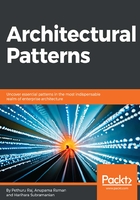
Issues in the master-slave pattern
The master-slave pattern works based on the pide and conquer principle. In the working of this pattern, the coordination concept is separated from the actual work as all the slaves work in parallel. Hence, the slaves have not shared state and they work in isolation. Another issue in the master slave pattern is its latency. This could cause an issue in systems where the response time is very critical, for example, real-time systems. Moreover, this pattern can be applied to a specific problem only if it is decomposable.
One of the ways of implementing the master-slave pattern is through a single master thread, which creates multiple slave threads. Each of the slave threads performs a variant of the required computation and returns the result to the master. Once the computation is complete, the master thread accumulates the results and terminates the slave threads.
Client-queue-client patterns
This is also called passive queue architecture. This is a variant of the client-server architecture in which all components, including servers, are treated only as client systems. This is because servers were treated as passive queues by the clients which are present in the system and are used by the clients for transferring messages to other clients present in the network. This architecture could be treated as one of the early evolutions of peer-to-peer architecture, which is discussed in the next section and is obsolete today.